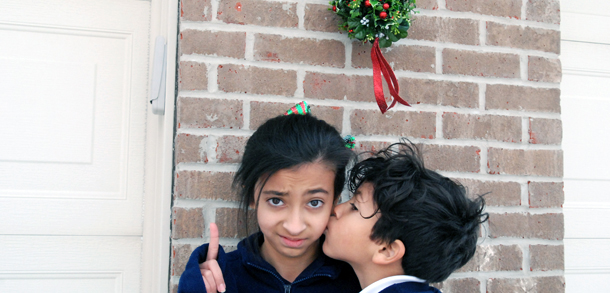I love decorating our home for the holidays, and my kids really get into it too. Every year, on the day after Thanksgiving, we pull out the decorations from the attic and add a little holiday cheer to each room. It’s one of my favorite traditions.
What you might notice, if you were to visit the Goertemoeller home, is the absence of some common decorations. Most notably holiday plants.
While plants add warmth to the home, some holiday varieties are potentially dangerous and warrant extra precaution. At our Drug and Poison Information Center, we receive about 35 calls each season from parents concerned about their child’s exposure to a holiday plant.
So as you’re decorating your home this year, how do you know which ones are safe to bring inside your home, and which ones should be moved outdoors or kept out of the reach of your children? Here is a list of the most common holiday plants, identified as either safe or potentially unsafe:
MISTLETOE*: potentially unsafe

While there’s no harm in kissing underneath the mistletoe, you’ll want to keep your children away from it. Certain varieties contain substances that can affect the nervous system, blood pressure and heart if consumed in large quantities. The berries have the greatest potential for causing symptoms of poisoning, although other parts of the plant are also considered toxic. Typically when we receive calls about children ingesting the berries, they’ve only consumed one or two, which isn’t a cause for alarm. However, if you think your child has eaten a berry, always call your Drug and Poison Information Center (DPIC) so that you can have a conversation about the details regarding what happened. *mistletoe photo provided by BerndH via Wikimedia Commons
HOLLY: potentially unsafe

There are nearly 400 different varieties of holly, and a few hundred of them are considered poisonous. If ingested, the berries can cause nausea, vomiting, diarrhea and central nervous system depression (slowing of breathing and heart rate). The berries can be black, brownish-black, red or rarely, yellow. If you’re trying to identify holly, it’s worth noting that not all of the varieties have sharp leaves, which can be poisonous as well. If you think your child has eaten any part of a holly plant, call your DPIC.
Jerusalem Cherry*: unclear, but avoid to be safe

The Jerusalem Cherry is believed to contain solanine, a substance that can cause dilated pupils, drooling, nausea, vomiting, headache, bloating, diarrhea, respiratory and central nervous system depression, confusion, irregular heartbeat, and coma . However, there have been very few reports of people having poisonous symptoms after ingesting the plant, and it’s not clear how many your child would need to eat for it to cause problems. To be on the safe side, if you think your child has eaten any part of the plant, call your DPIC. *jerusalem cherry photo provided by Taragui via Wikimedia Commons.
Poinsettia: safe

While it was once believed that poinsettias were poisonous, many reliable sources report that it is generally considered safe. The worst symptoms that could occur are minor gastrointestinal symptoms if eaten and minor local irritation if the eyes are rubbed after touching the plant.
Cyclamen: unknown

We just don’t know enough about this plant to determine its safety. It hasn’t been studied and there aren’t many reports about it. If you suspect your child has eaten any part of it, call DPIC just to be safe. We can talk you through any symptoms your child might be experiencing.
Christmas trees: safe

While there are no toxicity concerns with Christmas trees, it is worth noting that if you have an infant in your home, to be cautious about the sharp needles the tree sheds. They could potentially be a choking concern if your infant gets a hold of a tiny handful. If the bark of a cedar tree is ingested it could cause a stomachache and the sap can cause a skin rash.
Christmas cactus: safe

No worries here – we have found no evidence of a Christmas cactus causing any harm.
While some holiday plants have the potential to be more concerning, others are perfectly safe. Even though my kids are old enough now to understand how to handle potentially hazardous plants safely, I still opt to keep most of them out of our house. With younger cousins visiting, I think it’s best to hang them outside so that we can all relax and enjoy the holidays.
The Drug and Poison Information Center is available to answer your questions 24-hours-a-day at 1-800-222-1222.





